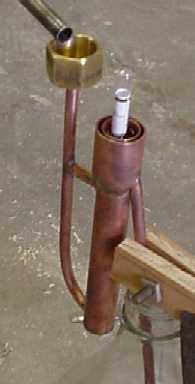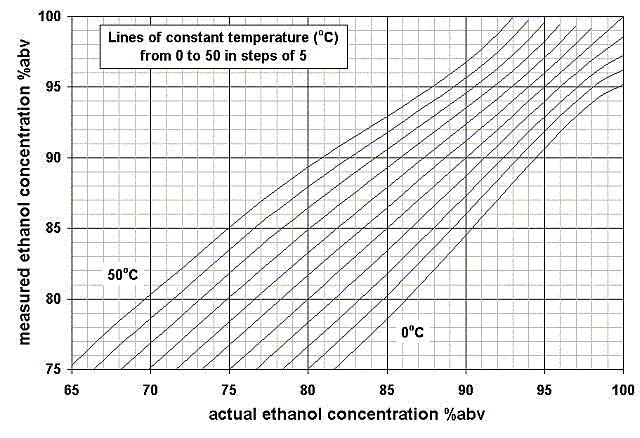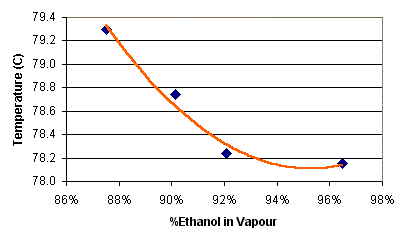
| Summary |
|
Once the still is up to temperature, and the distillate has started dripping,
make sure you throw away the first 50 mL per 20 L of wash, as this
may contain any methanol that is present. You should expect to collect the equivalent of approx 1L of 40% alcohol per kg of sugar used; the actual % purity will depend on the type of still you are using. Stop collecting the distillate once you notice them containing some fusels, or if the temperature gets above about 94 oC (it doesn't become "dangerous" or "deadly", just that it tastes foul). If you collect the distillate in small amounts (say 1/2 L or so), you can segregate the drinkable spirit from that with fusels in; the latter can be added to the next wash, and be collected cleanly then. "Genuine" whiskey can be made by passing a grain wash through a pot still twice. |

| You may be interested in something that I built so that I could monitor the quality of the output from my still. The device basically takes the output from the condenser and runs it past a hydrometer. I built this from a 6" length of 3/4 copper tube with a 1" tube flanged down and silver soldered at the top. I then connected a piece of 3/16 copper tube to the bottom of the 3/4 copper (input) and at the other end silver soldered on a funnel I then connected another piece of 3/16 copper to the 1" copper tube that collects the overflow from the 3/4 tube (Output tube). This connection was a little difficult as the 3/16 tube will not fit in between the 3/4 and 1" tube. To do this I drilled a small 1/8" hole into the side of the 1" tube and but welded it on. You could probably increase the 1" tube to 1.1/2" tube to make this easier The reason that the tube sizes are small is to ensure that the hydrometer can quickly follow any changes in output. A down side to the 3/4" tube is that if you have a high flow rate the hydrometer will give higher reading as flow of alcohol causes the hydrometer to rise. So if you are considering construction and you have high output rates you may need to increase the size of the tubes. This will of course decrease the sensitivity. I would also suggest to make sure that you hydrometer will fit inside of the 3/4" tube with some clearance for the output to flow past(My hydrometer is 1/2' diameter). | 
|

| Mash | First Distillation | Second Distillation
| Grains | to 18% (98 °C) | 85%-58% (80.5 °C - 92 °C)
| Fruit | to 25% (97.5 °C) | 85%-60% (80.5 °C - 91.5 °C)
| |
| Foreshots | 23 ml | (3.1%) |
| Heads | 130 ml | (17.4%) |
| Middle Run | 428 ml | (57.1%) |
| Tails | 168 ml | (22.4%) |

| http://homedistiller.org This page last modified |